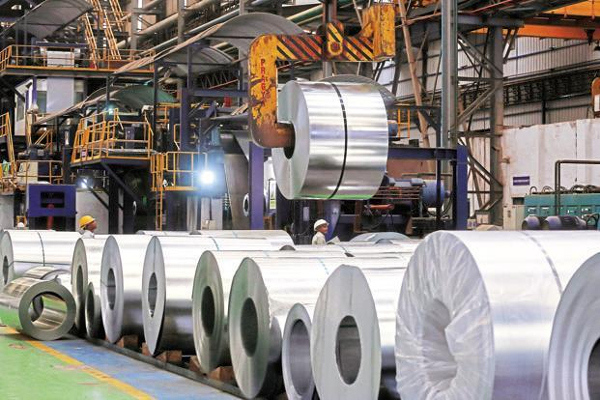The performance of Indian steel industry in FY19 deserves special mention amidst a minor slowdown in industrial production in the last few months. Crude steel production at 106.4 MT has made India climb up the second position, surpassing Japan and the differential is likely to get widened in the coming years.
The apparent consumption of finished steel at 97.5 MT, registering an annual growth of 7.5%, the highest among the global players, has made India nearly touching the level of the US and in all likelihood India would occupy the second position in steel consumption by the end of CY19. The finished steel production at 131.7 MT plus imports (finished) at 7.8 MT minus exports (finished) at 6.4 MT and after deducting inter plant transfer and double counting (HR to CR, CR to Coated, HR to Pipes) at 33.1 MT and adjusting for stocks (additions are minus with depletion as plus) of (-) 2.6MT, we get a finished steel consumption of 97.5 MT. A few aspects of this performance may be noted.
First, the consumption growth in carbon steel market is substantially lower at 5.7% as compared to consumption growth of 25% in alloy and SS market. The gross production of 11.03 MT in the special steel segment is a record and as these two segments are predominated by large number of SMEs, the rise in production and consumption has benefited SME sector the most. JPC data on alloy/SS category wise is currently made available only at the production level and not at the consumption level (even though imports and exports of alloy/SS is available product wise) which makes it difficult to arrive at product wise market share. The production data needs to be bifurcated at least into major producer wise (SMEs can be grouped together) to align with the reporting for the carbon steel market.
The market segments of the two types of steel are not entirely different and automobile, railways, transport (ART), architecture, building and construction (ABC) are the major common sets of consumption. It appears that growth rates in alloy/SS in these sectors enjoy the impact of low base volume and there is a distinct shift towards use of special steel by the consumers in these traditional areas. However, the auto sector after undergoing a steady monthly growth between 10-12% in the past one year is showing signs of deceleration at 7% growth in FY19.
The auto component sector is suffering due to lower orders from the car manufacturers. The repo rate reduction of 50 basis points in two tranches by RBI is likely to make personal loans cheaper and may stimulate demand in the sector in the coming months. As auto sector growth is employment intensive, it is essential that the sector gets back on rails early and demand for CRS, HRC, Rounds also moves up. This sector is also important to prompt domestic producers to build up capacities of making advanced high strength steel, body sheets and panels and thereby bring down imports of high value added steel. Nippon Steel, JFE, Hyundai, POSCO are some of the global players that have set up indigenous facilities (service centres) for supplying customised steel to auto sector and therefore the growth sustainability of the sector is a major determining factor for the success of Make In India programme.
Second, the total imports (including semi finished steel) in FY19 at 8.8 MT has grown by 4.6% over last year, while total exports at 8.5 MT falls short of last year’s level by 26.4%. The plausible reasons of the US’ unilateral act of duty enhancement under section 232 followed by retaliatory steps by China and the EU (definite safeguard duty and quota based entry) and the application of a wide range of ADD and CVD notified by many countries against various steel products have led to a shrinkage of space for the movement of steel for trading purposes and no wonder Indian steel exports have faced stiff entry barriers. The slower growth in global trade had its adverse impact on manufacturing growth also. It has resulted in limiting steel export destinations from India to Nepal, Italy, Vietnam and the UAE. While imports to India have been primarily undertaken by Japan, South Korea (under free trade in RCEP) and China, together accounting for 66.6% of total imports and maximum imports took place in respect of HRC, coated products, CRC and bars and rods, the product categories of HRC, semi finished steel, coated products, CRC and bars and rods comprise the major components of Indian steel exports in FY19. Melting scrap has been imported a record level of 6.6 MT in the year. The import of defective grade coated sheets to the tune of around 1,50,000 tonne worth `612.2 crore is a cause of concern.
Globally, the manufacturing sector is performing below desired level. The PMI in manufacturing in the US, China, Germany, South Korea and Japan at 52.4, 50.8, 44.1, 48.8 and at 49.2, respectively are generally lower than February level. The silver lining is that stimulus measures in terms of additional public investment and appropriate policy support (monetary and fiscal) for building of infrastructure, real estate, ports and ship building and other steel intensive sectors would continue unabated in the US, Germany, Japan, China, Indonesia, the UAE, Saudi Arabia and India. This factor alone would make the deceleration in specific sectors rather short lived.
Source: FE
Image Courtesy: LiveMint
You may also like
-
Trade Connect E-platform For Exports Is Single Window, Fast, Accessible And Transformational: Shri Piyush Goyal
-
Dot Simplifies Approval Processes For Telecom Licenses And Wireless Equipment
-
Coal Production and Supply Trends on Positive Trajectory
-
Union Minister To Release Booklets On Promotion Of Indigenous Species & Conservation Of States Fishes
-
2nd India-Japan Finance Dialogue held in Tokyo on 6th September, 2024
